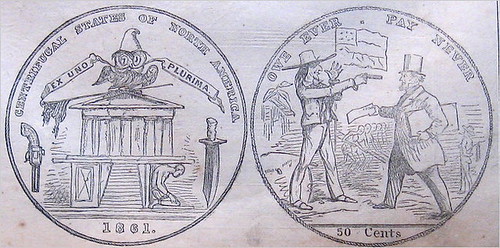
PREV ARTICLE
NEXT ARTICLE
FULL ISSUE
PREV FULL ISSUE
HARPER'S WEEKLY "PROPOSAL" FOR A CONFEDERATE STATES COIN
Tom Fort and Arthur Shippee forwarded this article from The New York Times about a satirical depiction of Confederate coinage from 1861.
-Editor
Tom writes: This is what 'real' Confederate coins should have looked like...

It was a wicked and ingenious little cartoon. At a moment when the rebel government was busily inventing its national emblems, flags, postage stamps and currency, Harper's Weekly the most widely read magazine in the North presented its own modest proposal: a mockup of a new coin for the Confederate States of America. The illustration, deceptively simple at first glance, is one of those pictures that becomes more complex and meaningful the more that you look. It even offers some prophecies that were to come true during the next four years of civil war. The anonymous artist yields not an inch to the pretensions of the new Southern republic or, as his coin's obverse inscription calls it, the "Centrifugal States of North America." Beneath this is a classical temple, already showing cracks in its faηade, and with an owl (harbinger of death and disaster) perched atop its pediment, wearing a dunce cap. The bird holds a torn and tattered American flag in its claws, while streaming from its beak is a ribbon with the Latin motto "Ex Uno Plurima" "Out of one, many." Flanking the temple on either side are weapons that Northerners considered typical of Southern ruffians: a revolver and a bowie knife. But most significant of all are the twin foundations on which the temple of the Confederacy stands: a bale of cotton and a kneeling black slave. On the reverse of the coin, a stereotypical Southern planter stringy hair, wispy goatee, broad-brimmed hat thumbs his nose and points his six-shooter at a stout Yankee banker who is trying to present him with a bill. (The motto above them drives the point home: "Owe Ever, Pay Never.") In the background, slaves toil beneath the gaze of a lash-wielding overseer. Even the coin's denomination half a dollar is freighted with irony. The cartoon in Harper's suggests yet a further irony: the Confederate government would never actually succeed in issuing its own coinage. In early 1861, rebel agents commissioned a Philadelphia engraver named Robert Lovett to create for a one-cent piece. He had barely managed to create the dies and strike a dozen or so prototypes before war began. Lovett prudently broke his contract and stashed away the evidence. A few prototypes of a Confederate half dollar were also struck that year at the New Orleans mint after its seizure by rebel forces. But production there and at the other two federal mints in the slave states Charlotte, N.C., and Dahlonega, Ga. soon ceased.
To read the complete article, see:
The Color of Money
(opinionator.blogs.nytimes.com/2011/06/21/the-color-of-money/)
The Numismatic Bibliomania Society is a non-profit organization promoting numismatic literature. See our web site at coinbooks.org. To submit items for publication in The E-Sylum, write to the Editor at this address: whomren@gmail.com To subscribe go to: https://my.binhost.com/lists/listinfo/esylum All Rights Reserved. NBS Home Page Contact the NBS webmaster 
|